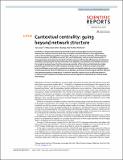Contextual centrality: going beyond network structure
Author(s)
Leng, Yan; Sella, Yehonatan; Ruiz, Rodrigo; Pentland, Alex
Downloadcontextual centrality- going beyond network structure.pdf (2.301Mb)
Terms of use
Metadata
Show full item recordAbstract
Centrality is a fundamental network property that ranks nodes by their structural importance. However, the network structure alone may not predict successful diffusion in many applications, such as viral marketing and political campaigns. We propose contextual centrality, which integrates structural positions, the diffusion process, and, most importantly, relevant node characteristics. It nicely generalizes and relates to standard centrality measures. We test the effectiveness of contextual centrality in predicting the eventual outcomes in the adoption of microfinance and weather insurance. Our empirical analysis shows that the contextual centrality of first-informed individuals has higher predictive power than that of other standard centrality measures. Further simulations show that when the diffusion occurs locally, contextual centrality can identify nodes whose local neighborhoods contribute positively. When the diffusion occurs globally, contextual centrality signals whether diffusion may generate negative consequences. Contextual centrality captures more complicated dynamics on networks than traditional centrality measures and has significant implications for network-based interventions.
Date issued
2020-06-10Publisher
Scientific Reports
Citation
Leng, Y., Sella, Y., Ruiz, R., & Pentland, A. (2020). Contextual centrality: going beyond network structure. Scientific reports, 10(1), 1-10.
Collections
The following license files are associated with this item: